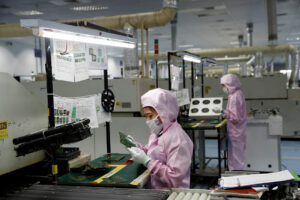By Beatriz Marie D. Cruz, Reporter
FACTORY ACTIVITY in the Philippines expanded at a steady pace in August amid a “modest” improvement in operating conditions, with firms ramping up production, S&P Global said.
The S&P Global Philippines Manufacturing Purchasing Managers’ Index (PMI) stood at 51.2 in August, the same reading in July.
A PMI reading above 50 denotes improved operating conditions from the previous month.
“The Filipino manufacturing sector showed sustained and modest gains midway through the third quarter. Growth in output and new orders accelerated on the month, thereby highlighting improving demand trends,” S&P Global Market Intelligence economist Maryam Baluch said in a report.
“However, employment fell, and buying activity cooled, suggesting that manufacturers remain cautious about growth prospects,” she added.
Based on the latest PMI data, the Philippines had the second-highest reading out of five Southeast Asian countries, only behind Thailand (52). Meanwhile, Malaysia (49.7), Indonesia (48.9), and Myanmar (43.4) all showed contractions.
As of publishing time, there were no data on Vietnam and Singapore.
The headline PMI measures manufacturing conditions through the weighted average of five indices — new orders (30%), output (25%), employment (20%), suppliers’ delivery times (15%) and stocks of purchases (10%).
For the Philippines, S&P Global data showed that overall growth in new orders was the strongest in three months.
“However, demand from foreign customers faltered in August, as new exports sales fell for the first time since the start of the year. The data thus suggesting that demand was domestically driven,” it said.
The pace of production accelerated in August from the four-month low in July.
S&P Global noted growth in business requirements prompted manufacturers to increase purchasing activity in August, although the rate of increase was the slowest in five months.
“The slowdown in buying activity was reflected in a softer buildup of pre-production inventories held at manufacturers. The upturn was slight and the weakest in the current six-month period of accumulation,” it said.
Post-production inventories dropped for the first time since February after five straight months of stock building, it added.
Philippine manufacturers were hesitant to hire new staff in August, reversing the uptick seen in July.
“Contractions have now been noted in three of the past four survey periods. Moreover, the tenacity of goods producers to complete workloads efficiently, despite a contraction in workforce numbers, highlighted sufficient capacity,” S&P Global said.
Inflationary pressures eased in August as input costs rose moderately, it said.
“Selling prices for goods were raised at a softer and only a slight pace, indicating that firms are in part absorbing costs in a bid to boost sales and remain competitive,” it said.
There were still delays in input from suppliers, with vendor performance deteriorating for the fourth month in a row. However, S&P Global said the recent delays were the “least pronounced” since May.
“The (manufacturing) slowdown could partly be attributed to the ghost month, inclement weather that led to some work/production disruptions,” Rizal Commercial Banking Corp. Chief Economist Michael L. Ricafort said.
Looking ahead, S&P Global said that Philippine manufacturers expect output to expand further in the next 12 months, with its PMI reading to likely stay well above the 50 mark.
However, the latest data showed a dip in the firms’ level of confidence.
“Confidence levels also waned in the latest survey period and hit a four-month low, further confirming that expectations surrounding the production outlook have softened,” Ms. Baluch said.
The central bank’s recent rate cut and expected easing in the fourth quarter are seen stimulating factory activity in the coming months, Security Bank Corp. Chief Economist Robert Dan J. Roces said.
“The Aug. 15 rate cut and the anticipated 25-basis-point (bp) reduction in the fourth quarter could positively impact purchasing activity in the coming months, as it may encourage businesses to invest in their operations, leading to increased demand for materials and supplies,” he said in a Viber message.
The Monetary Board cut rates by 25 bps at its August meeting, bringing the benchmark rate to 6.25% from the over 17-year high of 6.5%.
Bangko Sentral ng Pilipinas Governor Eli M. Remolona, Jr. has also said the central bank can cut rates by another 25 bps before yearend.
Lower borrowing costs may also boost consumer spending, increasing the demand for manufactured goods, Mr. Roces added.
Mr. Ricafort said that further policy easing by the Philippine and US central banks may lead to cheaper credit for manufacturers, and bolster trade and investment activity.
Markets are widely expecting the US Federal Reserve to begin cutting rates this month.






